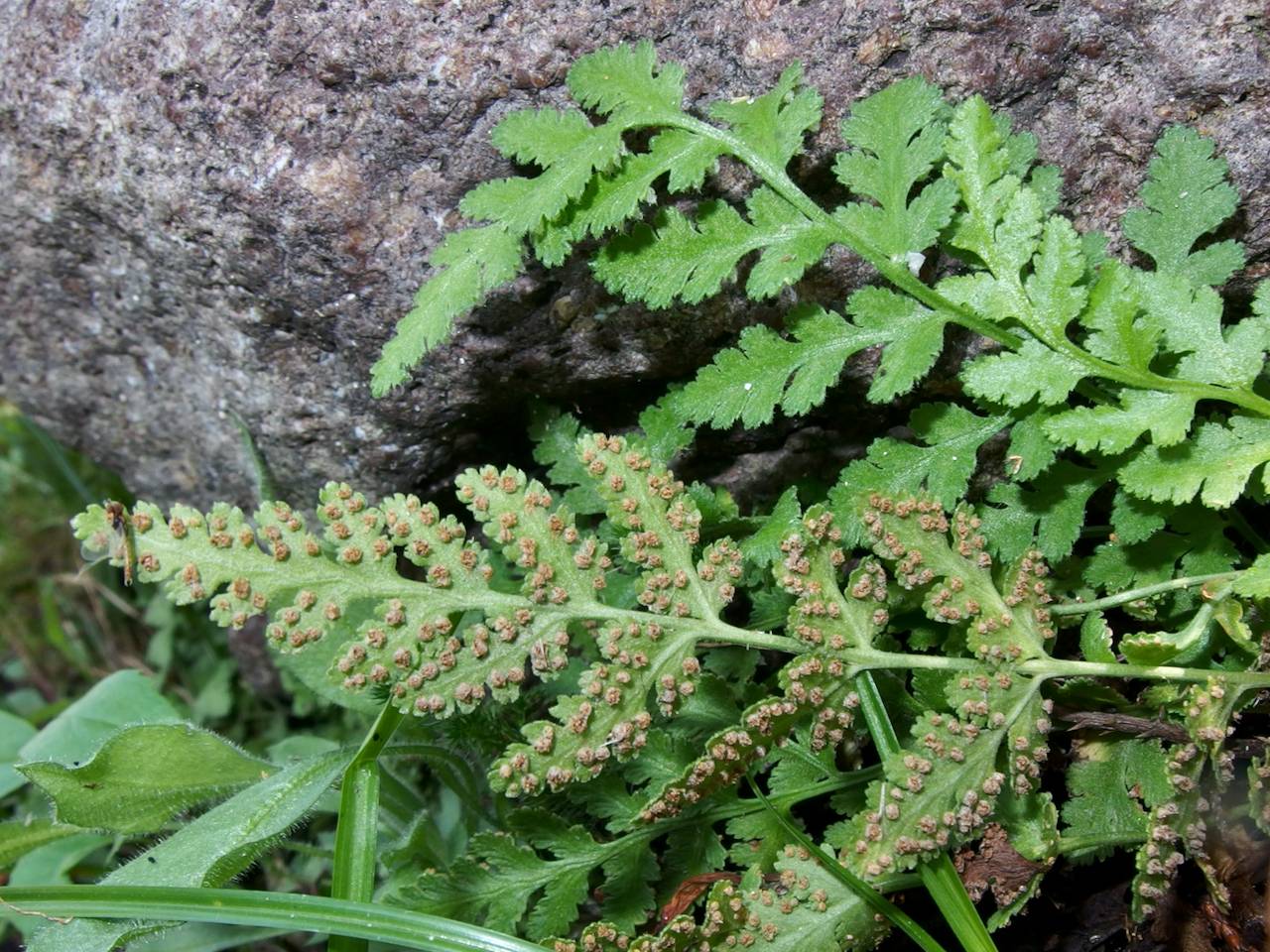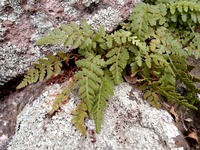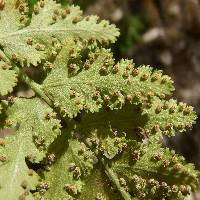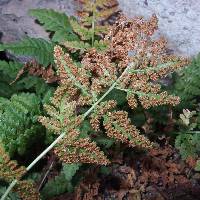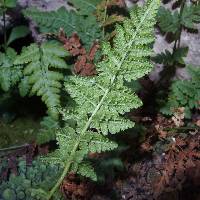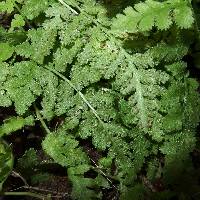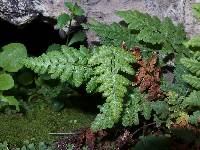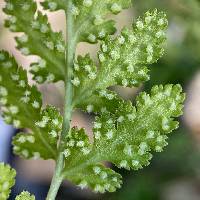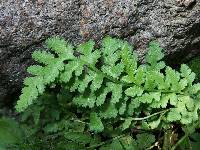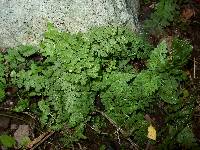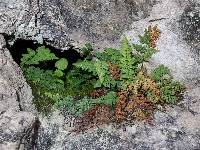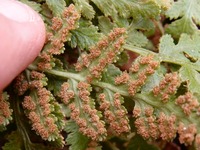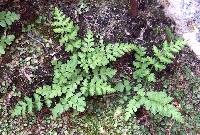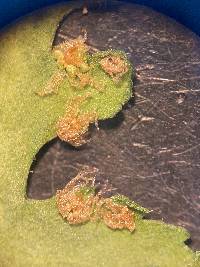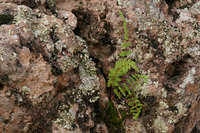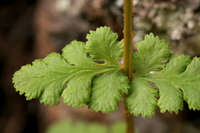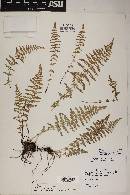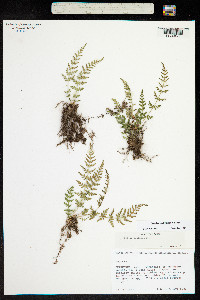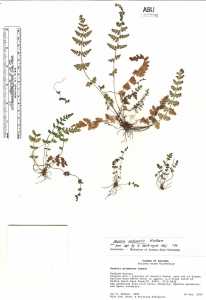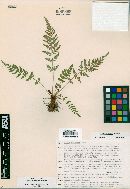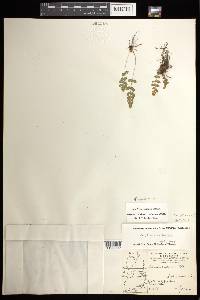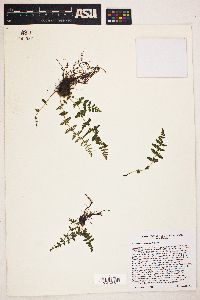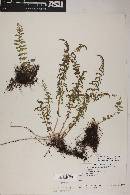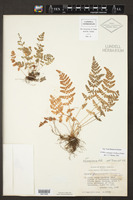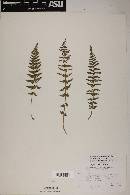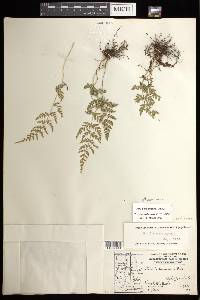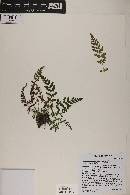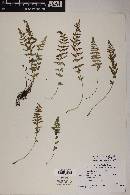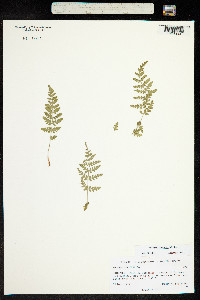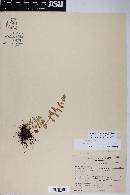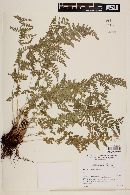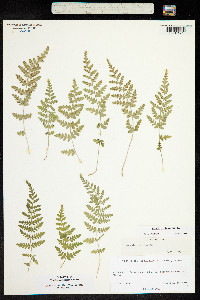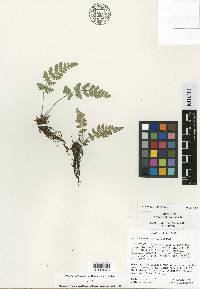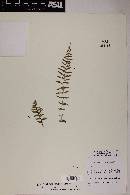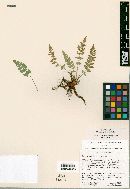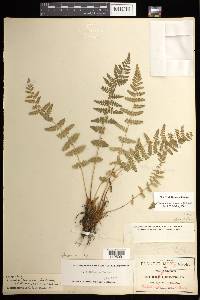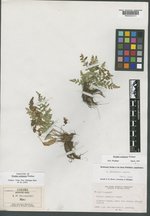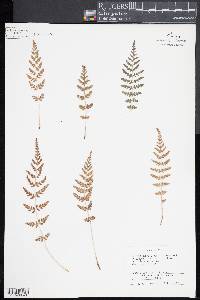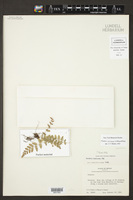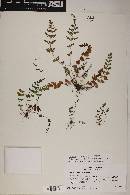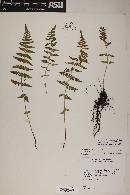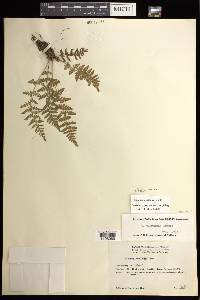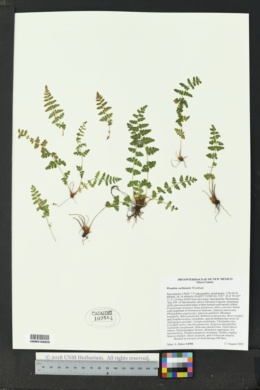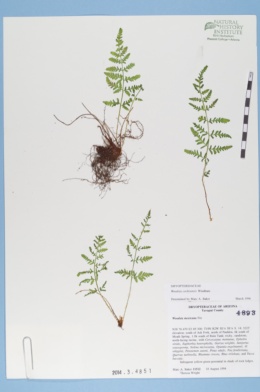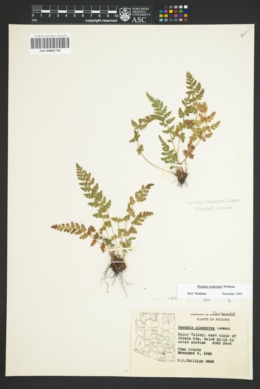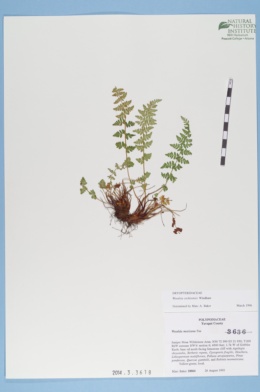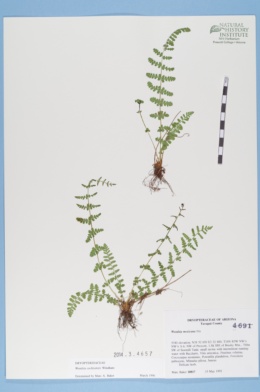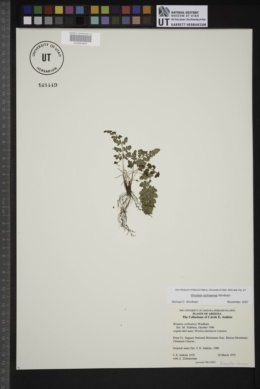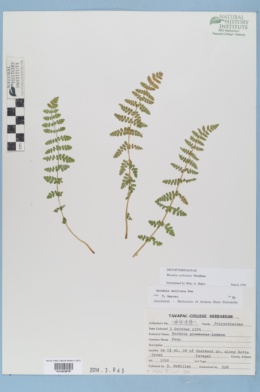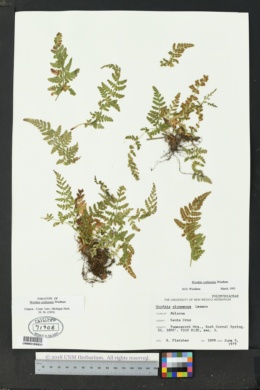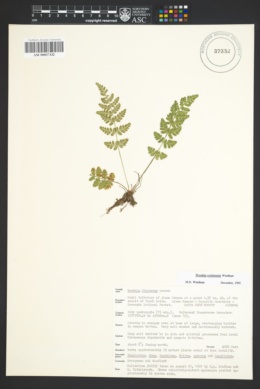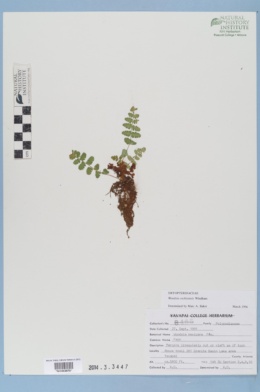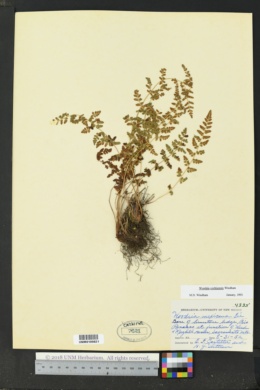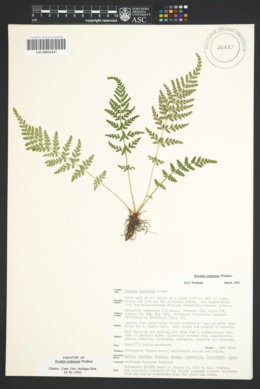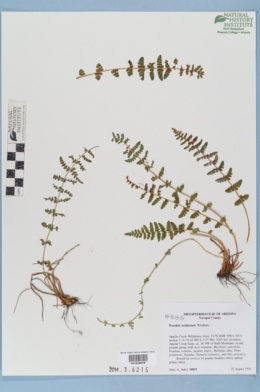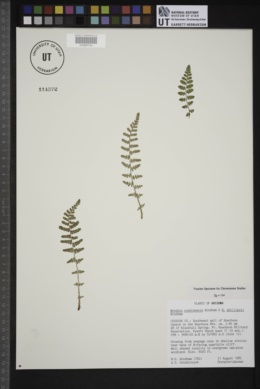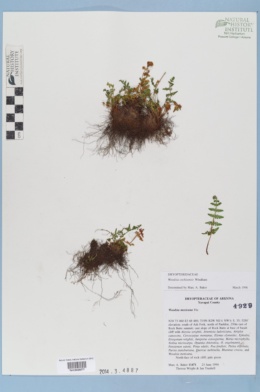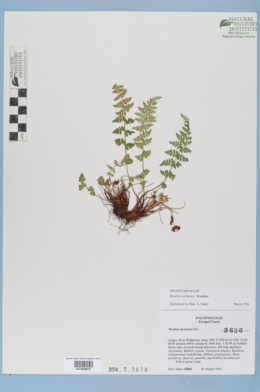
|
|
|
|
Family: Woodsiaceae
Cochise Cliff Fern
|
Stems compact, erect to ascending, with a few persistent petiole bases of unequal lengths; scales often uniformly brown but at least some bicolored with dark central stripe and pale brown margins, narrowly lanceolate. Leaves 5--25 × 1.5--6 cm. Petiole light brown or straw-colored throughout when mature, occasionally darker at very base, not articulate above base, relatively brittle and easily shattered. Blade narrowly lanceolate to ovate, pinnate-pinnatifid to 2-pinnate proximally, sparsely to moderately glandular, never viscid; glandular hairs with thin stalks and slightly expanded tips; rachis with glandular hairs and occasional hairlike scales. Pinnae ovate-deltate to elliptic, longer than wide, abruptly tapered to a rounded or broadly acute apex, occasionally attenuate; largest pinnae with 4--9 pairs of pinnules; abaxial and adaxial surfaces glandular, lacking nonglandular hairs or scales. Pinnules dentate, often shallowly lobed; margins lustrous adaxially, usually thickened, lacking cilia but sparsely glandular, with occasional 1--2-celled translucent projections. Vein tips enlarged to form whitish hydathodes visible adaxially. Indusia of relatively broad segments; segments multiseriate most of length, usually divided and uniseriate distally, composed of ± isodiametric cells, often surpassing mature sporangia. Spores averaging 43--49 µm. 2 n = 152. Sporulating late spring--fall. Shaded ledges and alcoves near springs and seeps; usually on granitic or volcanic substrates; 1000--2200 m; Ariz., N.Mex.; n Mexico. Woodsia cochisensis traditionally has been identified as W . plummerae or (rarely) W . mexicana Fée. It is readily separated from W . plummerae by the characteristics given in the key, and from North American members of the mexicana group ( W . phillipsii and W . neomexicana ) by having indusial segments that are broad and nonfilamentous at the base. Woodsia cochisensis is less glandular than typical W . mexicana from northeastern Mexico and is further distinguished from that species by the thickened, lustrous pinnule margins and well-developed hydathodes. Isozyme and chromosome studies suggest that W . cochisensis is an allotetraploid that may have originated through hybridization between W . phillipsii and an undescribed Mexican diploid (M. D. Windham 1993). It crosses with the former species to produce sterile triploids of intermediate morphology.
General: Plants usually on rock, stems compact, erect to ascending with persistent petiole bases of unequal lengths; scales uniformly brown, some bicolored with dark central stipe and pale brown margins, narrowly lanceolate. Leaves: On light brown or straw colored petiole, occasionally dark at base, 5-25 cm long by 1.5-6 cm wide, not auriculate above base, brittle and easily shattered; blade narrowly lanceolate to ovate, pinnate-pinnatifid to twice pinnate near end, sparsely to moderately glandular, never viscid; glandular hairs with thin stalks and slightly expanded tips; rachis with glandular hairs and occasionally hairlike scales; pinnules ovate-deltate to elliptic, longer than wide, abruptly tapered to rounded; largest pinnae with 4-9 pairs of pinnules; surfaces glandular; pinnules dentate, often shallowly lobed, margins lustruous above, lacking cilia. Sporangia: Indusia of relatively broad segments, segments multiseriate most of length, usually divided and uniseriate distally, often surpassing mature sporangia; spores averaging 43-49 microns. Ecology: Found in shaded places near water, usually on granitic or volcanic substrates from 3,500-7,500 ft (1067-2286 m); sporulates in late spring-fall. Notes: Was often confused with W. plummerae formerly, but is easily distinguished by the light brown or straw–colored basal parts of the petiole, sparsely glandular blades, and enlarged vein tips. W. cochisensis also has thickened pinnule margins, which are lustrous on the upper surface. Etymology: Woodsia is named after Joseph Woods (1776-1864) an English botanical author, while cochisensis refers to Cochise, the great Apache leader. Sources: FNA 1993 FNA 1993 Common Name: Cochise cliff fern Rarity: None General: Plants usually on rock, stems compact, erect to ascending with persistent petiole bases of unequal lengths; scales uniformly brown, some bicolored with dark central stipe and pale brown margins, narrowly lanceolate. Leaves: On light brown or straw colored petiole, occasionally dark at base, 5-25 cm long by 1.5-6 cm wide, not auriculate above base, brittle and easily shattered; blade narrowly lanceolate to ovate, pinnate-pinnatifid to twice pinnate near end, sparsely to moderately glandular, never viscid; glandular hairs with thin stalks and slightly expanded tips; rachis with glandular hairs and occasionally hairlike scales; pinnules ovate-deltate to elliptic, longer than wide, abruptly tapered to rounded; largest pinnae with 4-9 pairs of pinnules; surfaces glandular; pinnules dentate, often shallowly lobed, margins lustruous above, lacking cilia. Sporangia: Indusia of relatively broad segments, segments multiseriate most of length, usually divided and uniseriate distally, often surpassing mature sporangia; spores averaging 43-49 microns. Ecology: Found in shaded places near water, usually on granitic or volcanic substrates from 3,500-7,500 ft (1067-2286 m); sporulates in late spring-fall. Notes: Was often confused with W. plummerae formerly, but is easily distinguished by the light brown or straw-colored basal parts of the petiole, sparsely glandular blades, and enlarged vein tips. W. cochisensis also has thickened pinnule margins, which are lustrous on the upper surface. Ethnobotany: Unknown Etymology: Woodsia is named after Joseph Woods (1776-1864) an English botanical author, while cochisensis refers to Cochise, the great Apache leader. Synonyms: None Editor: SBuckley, 2010 |
|
|
|
This project was made possible in part by the Institute of Museum and Library Services [MG-70-19-0057-19].
Powered by Symbiota

